TEXT BY ANSHIKA SINGH
WITH INDU SINGH, G.N SINGH & R.N SINGH
PHOTOGRAPHS BY AANCHAL MALHOTRA
Noida, Uttar Pradesh
While I cannot remember when exactly in my childhood I first spotted this map of India, I know for certain that it would have been during any one of the winter afternoons I spent at my maternal grandparents’ home in Bhilai, Chattisgarh. Escaping Delhi’s winter in December to spend New Year’s with my nana and nani was an event my sister and I looked forward to throughout the year, which also formed our favourite memories of childhood.
If I try and delve into the past, I recall first seeing the embroidered map along with other framed pictures on an alcove in the wall of what we used to call the ‘achaar ghar’, an entire room in my grandparents’ house devoted entirely to pickles of all kinds – achaars and murabbas that my grandmother made with her own hands. Right from the ordinary aam or tamatar ka achaar to the lesser known and weirder ones like Jimikand or Yam, any possible pickle you could think of, she’d have it in there.
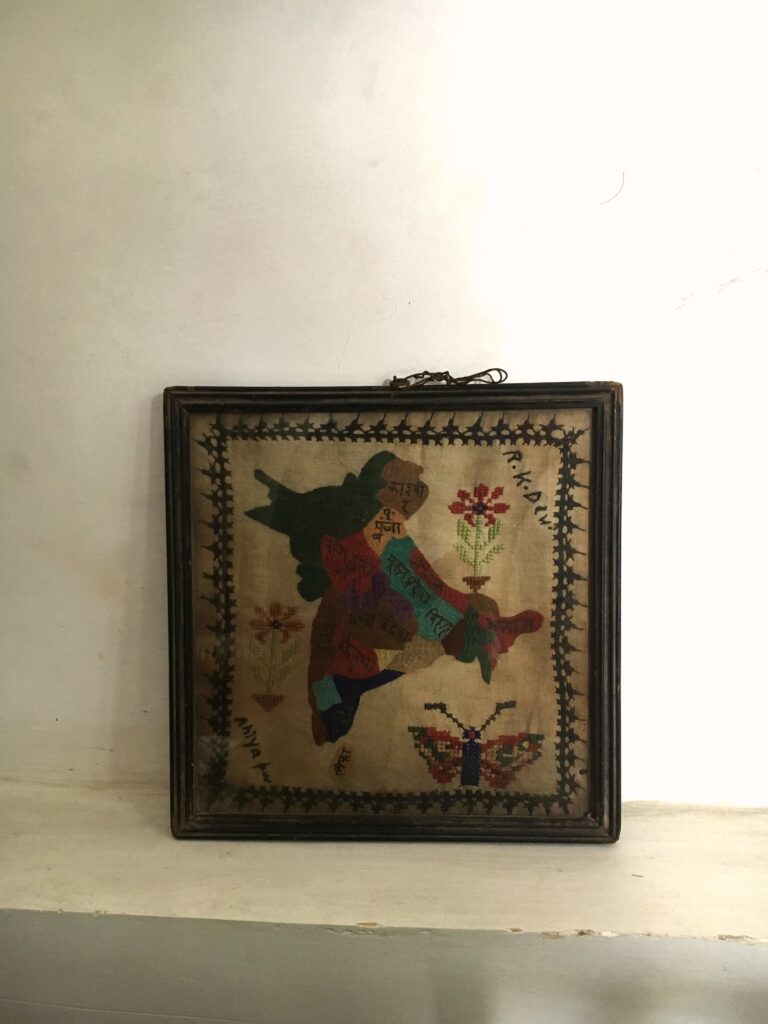
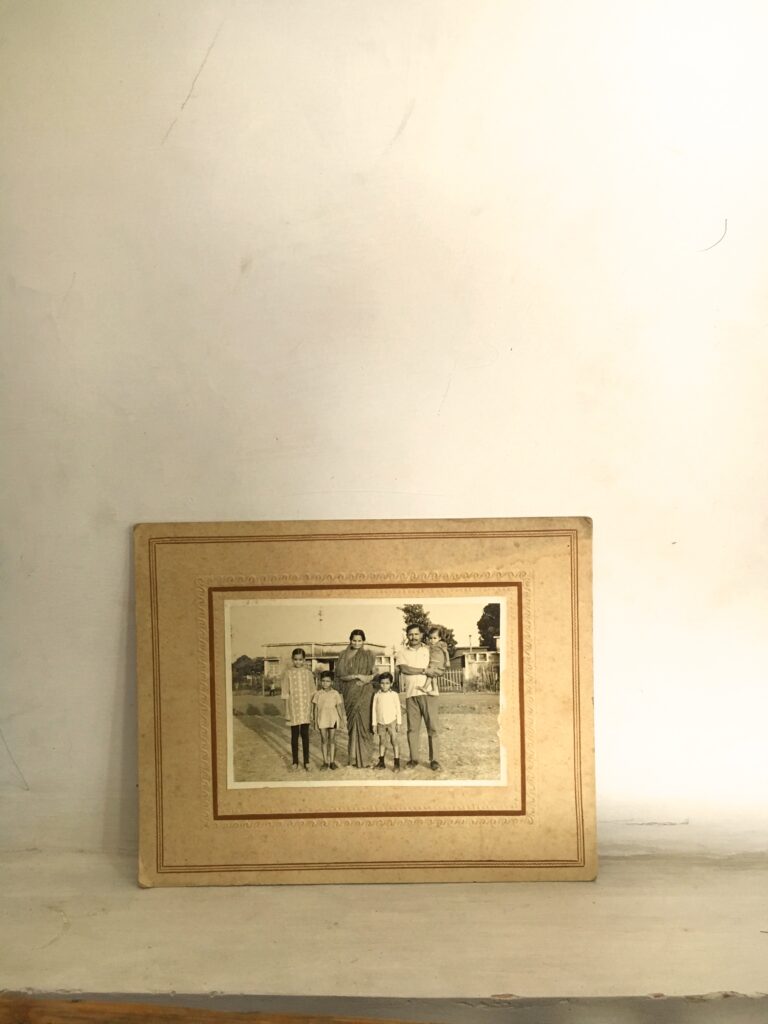
Even as a child, I admired the map for its age and antiquity, but in truth, my younger self was drawn towards it only after realising that the map within the frame was ‘wrong’. Or wrong, according to me. The number of states included in the subcontinent were far less, and the names and areas of the states didn’t correspond to the map of India I was familiar with. Incidentally, as I learnt later, when my mother was a child, she too, had teased my grandmother for the very same thing. But it was only when I took the map to her and asked her about its contours, did she reveal its historical and memorial significance.
My nani, Rajkumari Devi, had embroidered this map for a school competition in the year 1948 when she was only 8 years old. According to what she remembered of the event, her school in Amhara, Bihar was visited by some British officials, who awarded her 10 annas for the extraordinary embroidery she had done, despite her young age. The map she had sewn – the very map placed before me now – was the map of an independent India, just as it would have looked immediately after the 1947 Partition.
On either side of India, the territory of Pakistan can be seen sewn in a dark green colour, and west Pakistan marked as “Paschimi Pakistan” in black letters. Some of the states embroidered include Rajasthan in red, marked as “Raajputana”; Kashmir, Madhya Pradesh and rather extended ‘Bambai’ or Bombay in brown; Madras in royal blue, and the now known seven sister states sewn entirely as the Assam province in red. A faded mustard yellow represents Punjab, and the teal blue color marks the state of Bihar. Also included in the neighbourhood are the island of ‘Lanka’ or Sri Lanka in pale yellow, and Nepal in red.
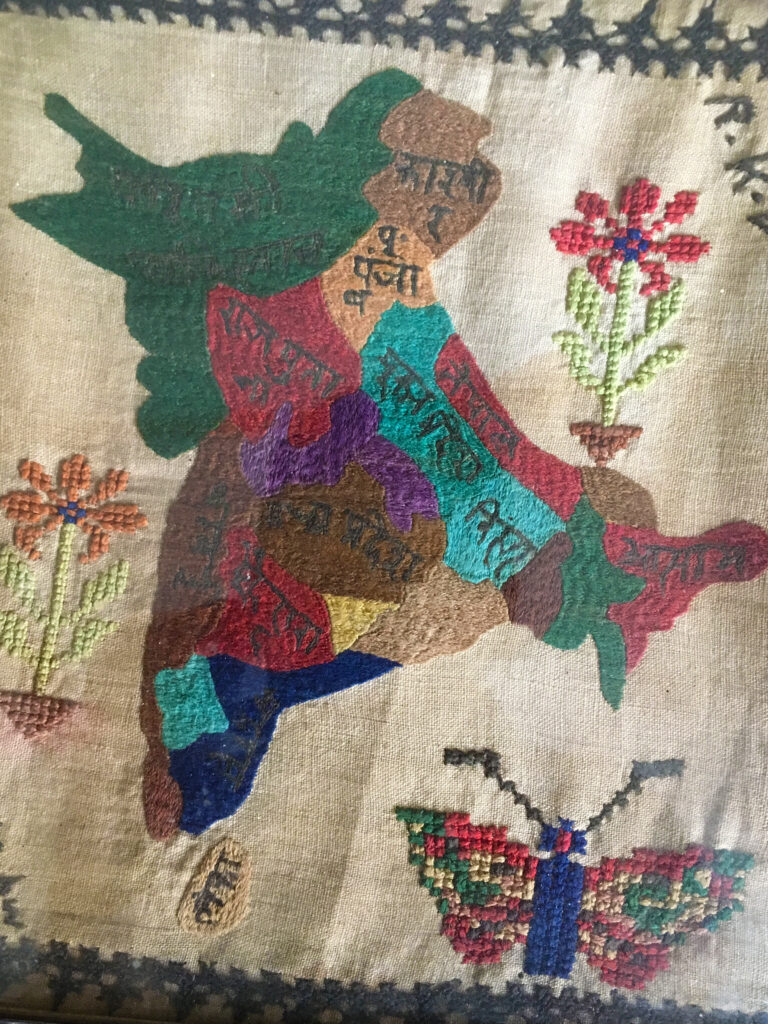
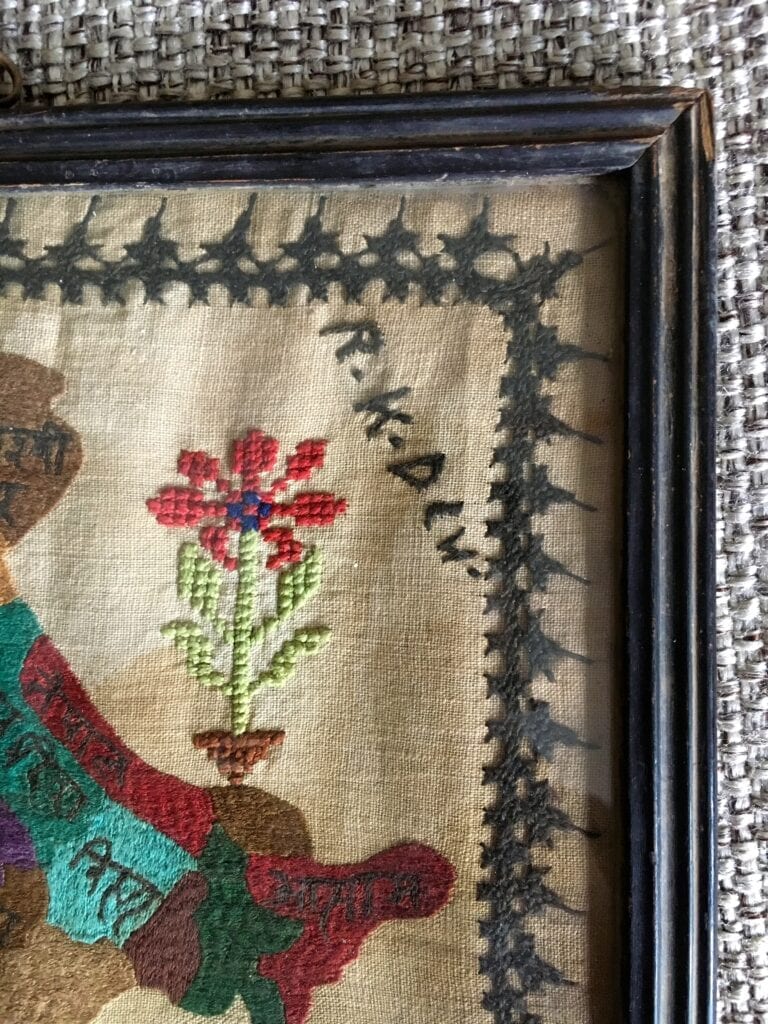
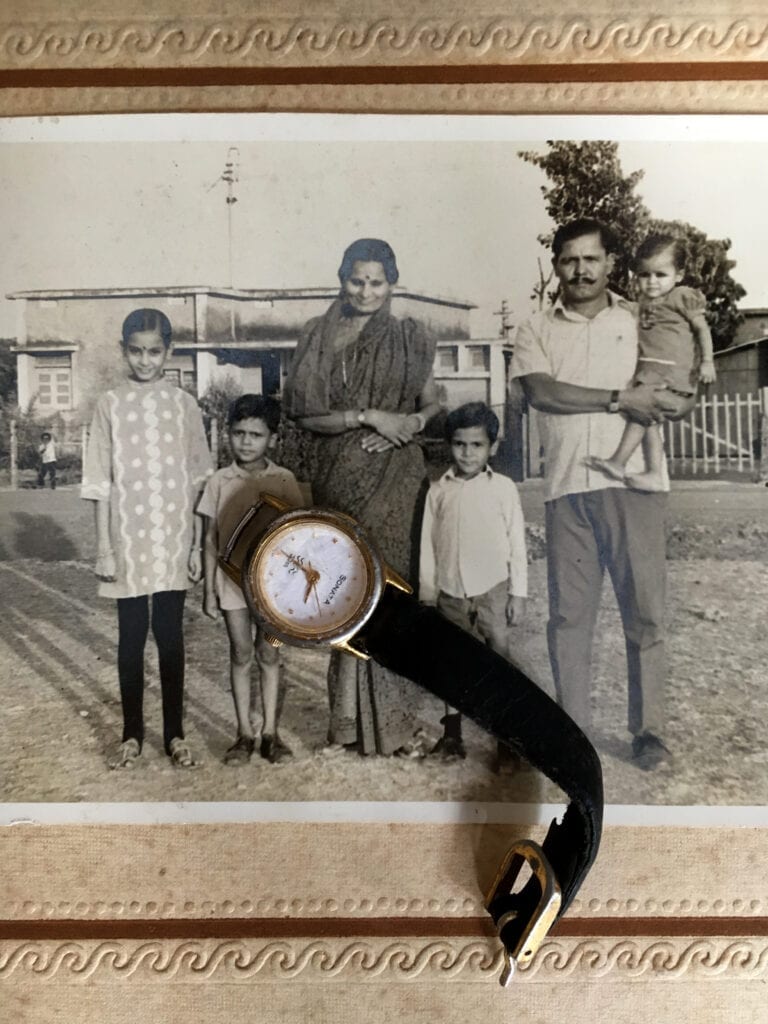
The embroidery done on fine white suti (cotton) cloth – as pointed out by my mother – exhibits four different types of kadhais, embroidery – Kashida (kashmiri), Sindhi, Cross stitch, (dasuti kadhai) and Back stitch (ulti bakhiya). While the border showcases pure Sindhi kadhai, the main body of the map is finely done in Kashida embroidery, and the names of states have been sewn in devanagari script using ulti bakhiya. Outside the map are two flowers: one red and one yellow, and a butterfly that follows a geometric pattern and can be easily identified as a cross stitch.
Having had a very strict elder brother who did not allow her to go out and learn embroidery, nani would often devise a ‘plan’ with her mother and sisters to sneak out of the house for a couple of hours, to visit a local woman who would teach her the threaded craft. She was in fact so passionate about it that during one of her trips to a relative’s home in Patna, she came across another woman nearby who charged 50 paisa to teach Sindhi kadhai, and ended up spending all her savings on it!
Nani ma was only 10 years old when she was married to my nanaji, R.B Singh, who was 12 years old. A few years after their marriage in 1950, she moved into his house in Ahiya Pur where they grew up together as best friends. This map was carried from nani’s house in Amhara to nanaji’s house in Ahiyapur as a part of her wedding trousseau. I suspect it existed as a rolled up piece of fabric back then, because it was only in their teenage years that nani ma asked nanaji to get the map framed. Since there were no framing shops in Ahiya Pur, or in the nearby areas at the time, he took the map to Patna and have it framed. Nani’s name- R. K Devi, and the place- Ahiya Pur, was added later to the map, probably after nanaji’s suggestion. Since nani ma learned Sindhi kadhai around the same time, I can also surmise that the border would have been added just before he was to take it for framing.
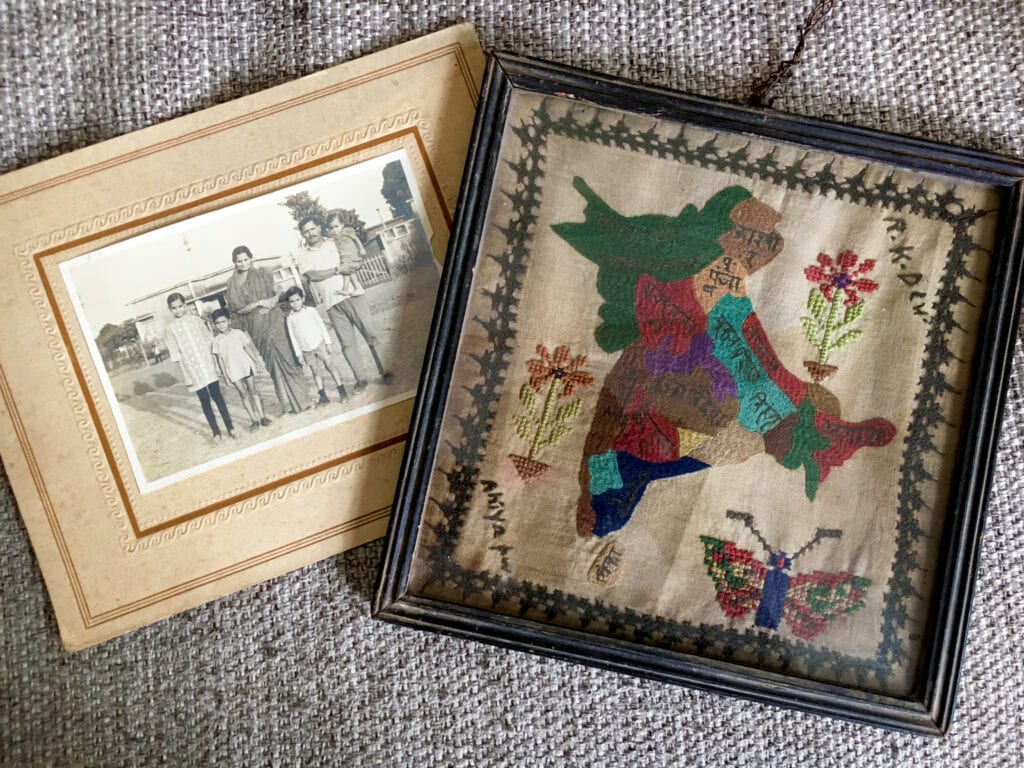
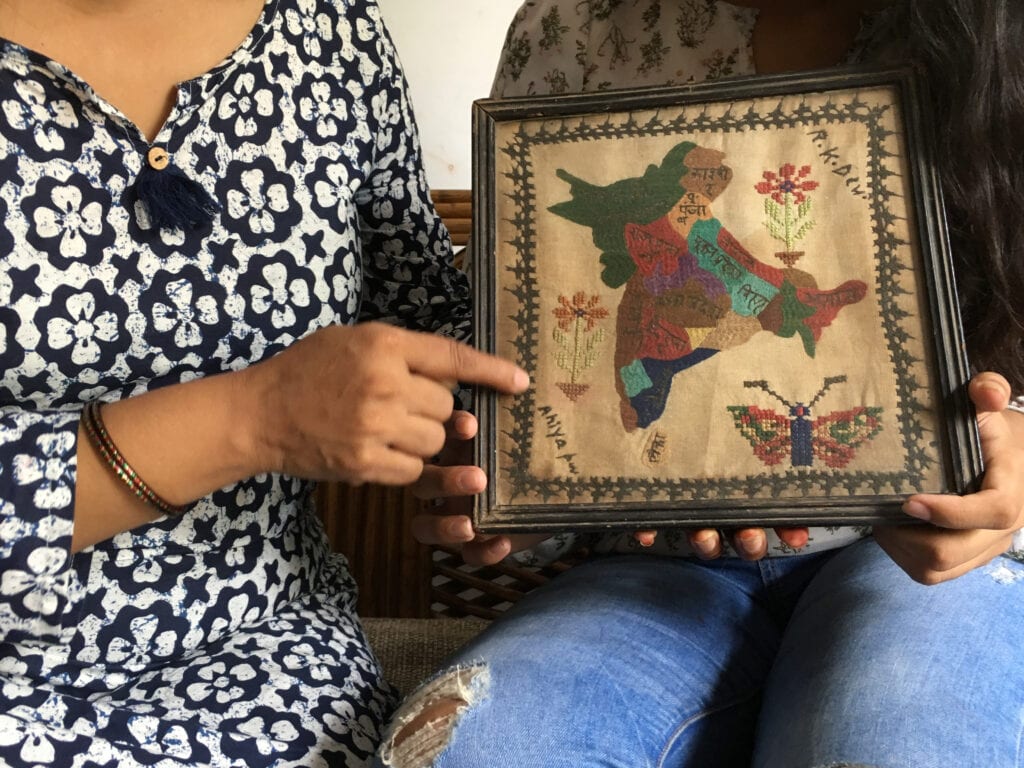
I remember asking nani years ago if I could take it back with me to Delhi, to which she immediately and quite politely refused, quoting the reason that as a piece of childhood embroidery, it didn’t quite “stand out” as much as other pieces she had made later on. She stressed that she wanted me to have something more “valuable”. It was rather ironic to hear her say that, for what I held in my hands was invaluable. Of course, only later did I realize that it was a possessive heart trying to coax its emotions into a polite explanation, to avoid parting with the only material possession of her childhood.
After nanaji’s death in 2017, nani maa’s health started deteriorating and eventually she preferred her days to be solitary, remaining almost always in her room. Knowing about the colorful life she had lived, it took me by surprise to see her refusing things which she had once loved. The last time I met her was in March 2018, when she was too weak to even sit on the bed by herself. Her voice had become feeble and muffled, and she was unable to talk for more than a few seconds at a time.
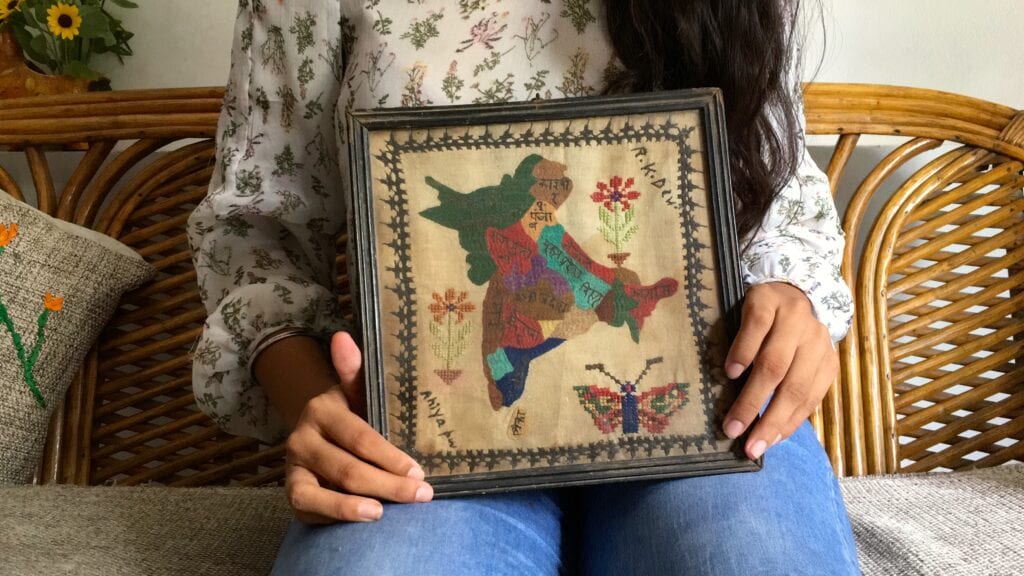
I remember laying next to her and for the second time, asking if I could keep the embroidered map. “Nani maa, vo map rakhlun mai? Jo aapne school mei banaya tha?” I asked. The years having dulled her zeal, she responded pragmatically, with, “Ekra kochi karbe, rakhle, What will you do with it? Keep it if you want.”
This 9.5 x 9.5 square inch of framed embroidery has lived through the latitudes and longitudes of displacement, and continues to stand the test of time- where the long ripped mounting board, and the cracked and loose joints of the wooden frame refuse to fall apart, complementing the graceful aging of the white suti cloth into a pale yellow fabric with occasional dark spots spread across it. It’s been a year since nani ma passed away, and every glance at this map is a flashback of memories which are usually too overwhelming to recall all at once. For now, it sits on my bookshelf wrapped carefully in bubble wrap to protect it from any possible damage, but I hope that one day, I may muster whatever courage it takes to have it live unsheathed, displayed on my walls for the world to see nani ma’s legacy.

Ngl, this was pretty wholesome and nostalgic
A well written one too